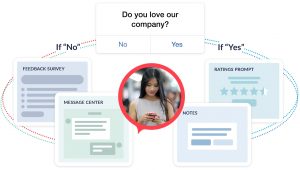
Customer feedback can reveal opportunities for major business growth—what customers want, straight from their own mouths. Instead of relying on hunches, companies can make confident, data-driven decisions that save time and money.
Customers benefit from sharing feedback too. According to AgilOne’s Consumer Survey, over 70% of US and UK consumers expect some form of personalization from the brands they buy from. Consumers want a personalized customer experience, and they’re willing to hand over data to get it.
Online surveys are an essential tool in any customer feedback program. They give companies a simple and effective way to collect customer feedback at critical moments in the customer journey.
The feedback conundrum
Despite their willingness to share personal info, the majority of customers report that they’ve abandoned a survey halfway through. And some research suggests that average response rates hover around 26%, while others say a response rate between 10-20% is reasonable.
This is a unique problem. Consumers like personalization, but they aren’t always willing to help companies give it to them. So in order to gather the customer feedback they need, companies have to craft surveys that engage their respondents from start to finish.
We’ve created this guide to teach you everything you need to know about maximizing online survey response rates. Read on to learn more.
Online Survey Response Rates 101
What affects survey response rates?
For starters, let’s talk about what affects online survey response rates and why.
1. Survey purpose
If recipients don’t know why they’re being asked to share feedback, response rates will suffer. Respondents want to know how their feedback will be used—and especially how it will impact their experience. State your goals and explain why recipients’ feedback is valued.
2. Survey length
Have you ever been in a meeting that you expected to take 10-15 minutes and suddenly you’re checking your watch an hour later? You lose focus, you contribute less, and productivity plummets.
Don’t let your respondents fall victim to the same thing. When you don’t set expectations from the get-go, you’re welcoming abandonment. Few people are willing to dedicate 20 minutes to a company survey without a crazy incentive.
Always tell recipients how many questions they’ll be asked or how long a survey will take. And, of course, try to keep your survey as quick as possible. We recommend no more than 10 questions, or about 5 minutes to complete.
3. Survey questions
There are a variety of survey question types to choose from—multiple choice, rating, grid, etc. Each survey question type takes a different amount of time to complete and thus has a unique impact on response rates.
Here are a few simple guidelines to consider when writing your survey questions:
- Only ask for the necessary information. Make a list of everything you’d like to know about your customers. Then, one by one, eliminate any non-essential questions. While this minimalistic approach may seem to undermine your mission for info, the exercise will help you avoid high abandon rates and ultimately get more from your surveys.
- Keep survey questions simple. Make sure your questions are direct, to the point, and leave no room for interpretation. Ask yourself each question aloud as you go. If it doesn’t sound right when you say it, it won’t feel right when your customers read it.
- Ask closed-ended questions. Compared to open-ended questions, multiple choice and scalable questions take less time to answer and they’re much easier to analyze. Closed-ended questions also leave less room for user demographics to impact response rates, whereas an open-ended question like How do you feel about our service? opens the floodgates to response bias. Of course, free-form feedback can prove really valuable, so include an open-ended question if you think your survey calls for it. Just consider the impact it could have on your response rates.
4. Survey design
Research suggests that visual IQ is rising and over 84% of communication will be visual by 2018. That means that good survey design is key to increasing online survey response rates. A poor respondent experience will often lead to abandonment. And the next time a customer receives a survey invitation from your company, they’ll expect a bad experience.
Pay attention to the look and feel of your survey. Make sure it’s on brand, easy to read, and appealing to your target audience.
5. Mobile optimization
To increase engagement, surveys need to live where your customers live: on their phones. Mobile-only internet users surpassed desktop-only in 2015—a major landmark in the mobile space. With more people relying on their phones to get online, mobile usage is skyrocketing for web browsing, shopping, and basic day-to-day tasks. From 2010 to 2015, email opens on mobile grew 30%, leaving desktop and webmail clients in the dust.
Long story short, if you’re sending email surveys to customers, you need to assume they’re opening them on their phones. If the design and handling aren’t spot on when they get there, they won’t be sticking around. No responses, no data, no progress.
On the other hand, mobile surveys are optimized for the device. They go where your customer goes, and they look great regardless of where your customer opens them. It’s a simple but powerful act of customer service that rakes in more responses and limitless rewards.
6. Survey frequency
How often do you ask customers for feedback? Frequency can affect online survey response rates too. If you bombard your audience, your response rates will dwindle.
According to Satrix Solutions, you can safely survey customers every two months. Exceed that, and you’re risking “survey fatigue,” which means recipients just get plain tired of your asks.
This rule applies more to general experience surveys—like Net Promoter Score and marketing surveys—than it does to transactional customer satisfaction surveys, which are typically quick and relevant to the customer’s latest experience with your company.
How can you increase survey response rates?
Now that we’ve covered the basics, let’s go over some creative ways to increase online survey response rates.
1. Offer an incentive.
Incentives can increase survey response rates substantially. They show customers that you value their feedback and appreciate their time. So what kind of incentives work best?
- Prepaid incentives: Companies sometimes give survey recipients an offer, regardless of whether or not they complete the survey. For example, they might send a $ 5 coupon code along with the survey invitation. This is pretty effective. In fact, research indicates a prepaid incentive can triple online survey response rates. But some companies (understandably) aren’t willing to make that kind of investment without any guarantee.
- Promised incentive: A promised incentive is given to respondents upon survey completion. In this case, both the respondent and the company get what they want. You’ll see an increase in response rates with promised incentives, but not as much so as with prepaid incentives.
- Lottery: Some companies incentivize respondents with a lottery. By completing the survey, respondents are entered into a drawing for a prize—like a $ 500 in-store gift card. Research shows this method does not significantly improve online survey response rates. However, if it’s the only incentive that makes sense for your business, go for it.
Here’s a great chart that explores the pros and cons of each type of incentive.
2. Segment survey participants.
Sending surveys to specific customers can drastically improve response rates. Let’s say you’re conducting a customer satisfaction survey about your latest fur-lined, waterproof winter boots. Rather than sending that survey to everyone, you should just send it to customers that have recently purchased the boots.
Or, let’s say you’re looking to expand your product line and want to know what products your customers are most likely to buy. You’d get the best feedback from loyal customers that are already familiar with your brand.
Creating an effective survey is only half the battle—sending it to the right audience is key if you want quality feedback. If you integrate surveys with you CRM, segmentation becomes simple. For example, you can automate survey distribution with GetFeedback for Salesforce using workflows.
3. Send surveys at the right time.
Timing is everything. You’ll get the best response rates occur when surveys are timed appropriately—not too early or too late after an experience.
Let’s go back to our winter boots example. If you want to collect feedback about this product, you should send the survey within a few days of a customer’s purchase. If you wait too long, you’ll miss your window. Or if you send too soon, you may catch the customer before they’ve had a chance to form an opinion.
If you intend to collect feedback on specific, recent experiences, sending a survey within a few days of completion is best practice.
4. Create the perfect survey invitation.
There are three questions every survey taker wants answers to immediately:
- What’s the survey’s purpose?
- How long will this take?
- What’s in it for me?
Make sure you answer all three in your survey invitation. Paragraphs of flowery text aren’t necessary—just get to the point. Tell respondents why you’re asking for feedback, how long it’ll take them, and what they’ll get in return.
Check out our tips on writing effective survey email subject lines so you increase your open rates too.
Wrap-up
As you incorporate these tips into your online survey strategy, you should see higher completion rates and better customer insights. What drives customer satisfaction? Where can you improve? What issues are damaging your retention rate?
To start answering these questions, you just need to ask.
If you need help creating and sending unique surveys, try GetFeedback for free. We offer a variety of free survey templates to help you design a beautiful, branded, mobile-friendly survey that collect feedback you can count on.
Digital & Social Articles on Business 2 Community
(92)





